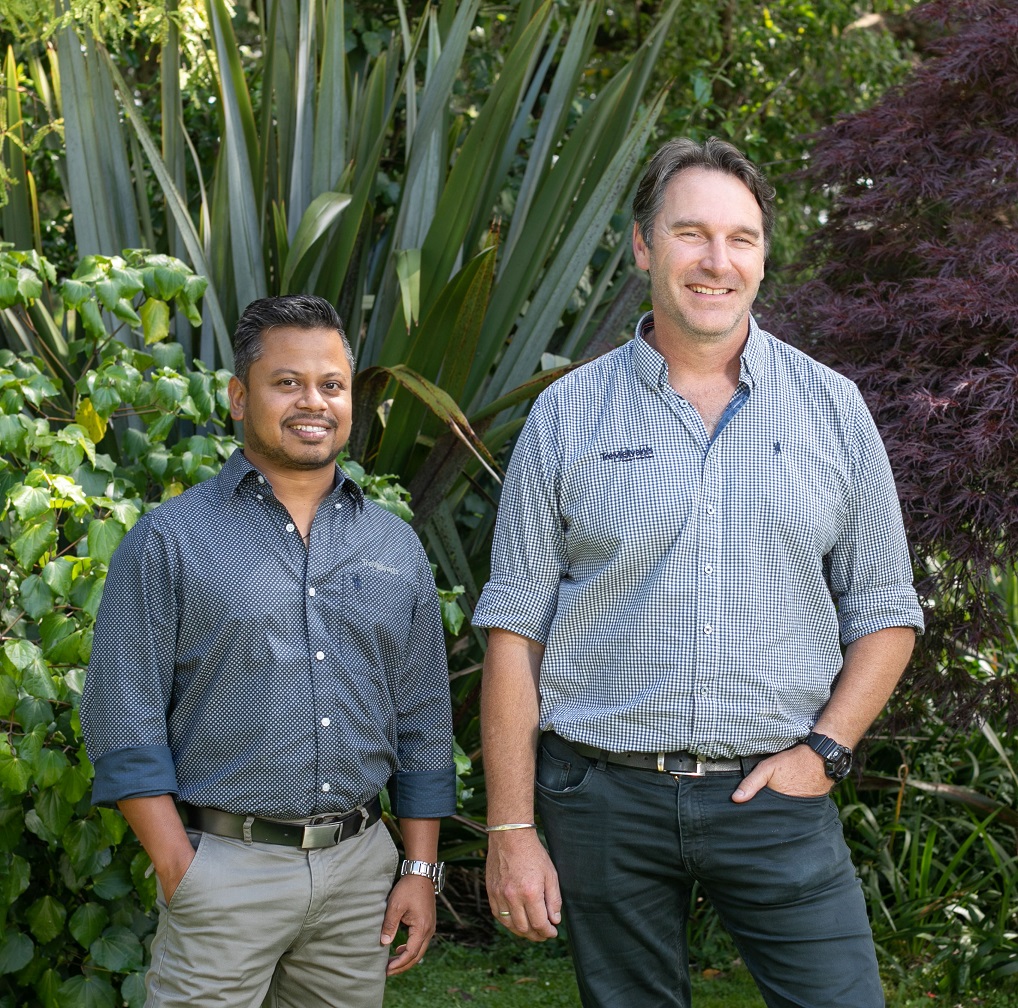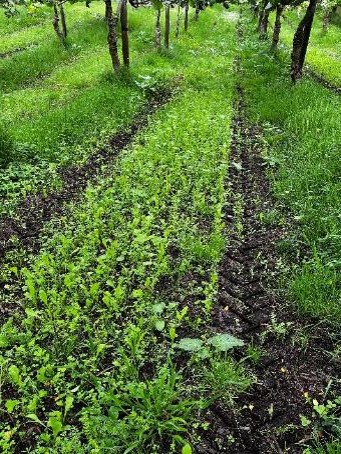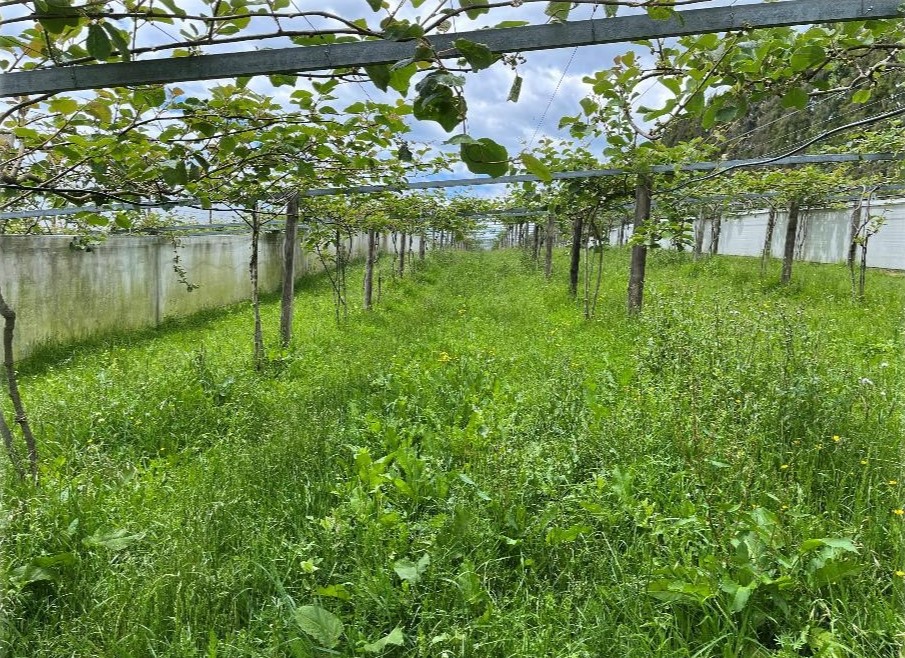A pioneering biodiversity project aimed at identifying understory planting benefits in kiwifruit is utilising knowledge and resources shared through the A Lighter Touch programme.
The project started two years ago when Trevelyan’s Pack and Cool Kiwifruit Technical Manager Dr Pranoy Pal and Head of Technical Gordon Skipage were approached by a kiwifruit grower in Pukehina about a soil erosion problem in a section of their orchard.
With a PhD in soil science, Pranoy investigated establishing an understory to aid with soil retention and soil improvement, using a 16 species shade tolerant seed mix that was already commercially available. Kiwifruit canopies are notoriously dense which means that there is little light penetration for five to six months of the year, making growing an understory challenging.

Trevelyan’s Pranoy Pal and Gordon Skipage. Credit Trevelyan’s.
In the next stage of the project, Pranoy and the project team plan to introduce moveable biodiversity pods and flower species row planting into the understory and/or headlands; this will provide a continuous source of shelter, nectar, alternative food and pollen that should attract and maintain beneficial insect populations.
The moveable pods and annual flower strip planting are two of the components being demonstrated at the Pukekohe demonstration farm as part of the A Lighter Touch-Vegetables New Zealand-Onions New Zealand biodiversity project.
Pranoy says that they have developed their understory project, utilising knowledge from a range of biodiversity projects and sources, including A Lighter Touch (ALT), and through collaboration of product groups: ALT has enabled different industry sectors to learn from each other, both via demonstration projects and sharing of resources and learnings.
With funding support from Zespri, the first stage of the Pukehina understory project was developed in a one-hectare gold kiwifruit block growing in pumice soil, Pranoy’s expertise with biochar was utilised when planting the understory. Alongside an untreated ‘control’ area, one trial area contained a mix of biochar and the seedmix, one biochar only and a third the seedmix only.

Understory growth in the kiwifruit block in early November, about seven weeks after sowing. Credit Trevelyan’s.
The understory was planted in mid-September and was well-established within two months, despite significant rain days after planting and a heavy frost in the first three weeks. Kiwifruit thrives in fungal-dominant soil, and soil testing of the trial sites showed a lift in the active fungi within three to four months. Further testing showed the benefit continued for six to eight months following the planting. The trial area showing best results was the biochar and seedmix combination.
In the second year of the project, with further funding from Zespri and support from Plant and Food Research scientists at Te Puke, ten more treatments were trialled on the same orchard in a different location. The same seedmix was used, with a combination of treatments including biochar and compost, biochar only and compost only. This work was carried out over the past season and is still being evaluated.
Pranoy says the next stage of the project, (subject to funding support) is looking at how to utilise the understory not only for soil health benefits, but also to enhance beneficial insect populations. One approach is to use moveable pods and alternating flower species rows in the understory, and another approach is to plant flower species on the headlands and assess the dispersal of the beneficial insects into the orchard.
“The challenge for us is the amount of shade in the understory. We can probably address that issue by cycling them three days in the sun and four days under the canopy.
“We do know that the understory planting we’ve done so far has helped soil biology, however, we also want to see that if we use tools like the moveable pods, will this increase the beneficial insects in the orchard for pollination and predation of pest insects,” Pranoy says.
The timing of flower row species is also a consideration. It is essential to establish the flowering understory in the three months leading up to mid-spring/early summer, so that it assists with pollination and pest control. A second planting of non-flower species would then follow as the kiwifruit canopy filled in, aimed at increasing the organic carbon in the soil.
Pranoy says there is a lot of learning going on in these early stages and he is keen to share the knowledge they gain. He also encourages other kiwifruit growers to go out and try it and then feed their experiences back into the work that Trevelyan’s is doing.
“One of our Trevelyan values is Work Smart and a part of that is the continuous cycle of improvement; evolve, adapt, innovate and we just may achieve!”
With kiwifruit orchards expanding into new regions with different soil compositions than the traditional growing areas, Trevelyan’s sees a greater need for developing these type of cultural practices on orchards.

The established understory planting. Credit Trevelyan’s.
“As our knowledge develops, we’d like to see tailor-made seed mix recipes that address the specific benefits an orchard needs; a custom approach for any orchard, whether it’s a new block or an established orchard.”
Pranoy sees the importance of working with others who are like-minded and values the knowledge and resources shared from a variety of sectors, including viticulture cover cropping and the work through ALT in vegetable crops and perennial fruit trees.
He is part of a six-member committee of kiwifruit growers and industry representatives who have created a Kiwifruit Regen/Soil Biology group, and they are holding their inaugural Kiwifruit Regenerative/Soil Biology Field Day on August 15 in Omanawa, Bay of Plenty.
“We’re keen to bring together a diverse group of growers; early adopters, people who have tried cover crops, as well as those who are interested in what we’re doing, to share and grow knowledge in our sector.”